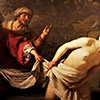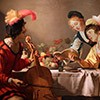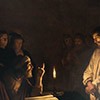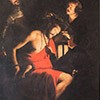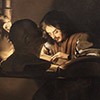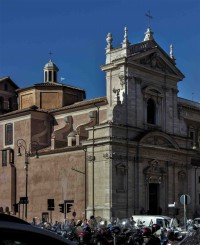
Gerrit (Gerard) van Honthorst, Susanna and the Elders, 1655, Galleria Borghese
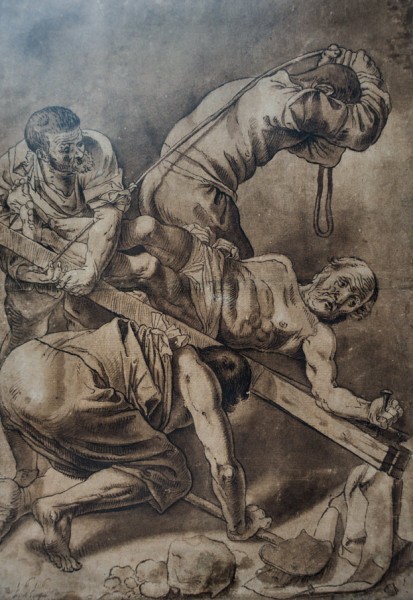
Gerrit van Honthorst, The Crucifixion of St. Peter, drawing based on Caravaggio's painting, Nasjonalmuseet, Oslo
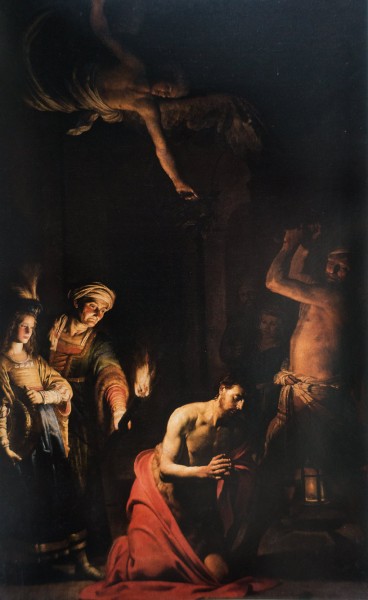
Gerrit van Honthorst, The Beheading of St. John the Baptist, 1617, Church of Santa Maria della Scala

Gerrit van Honthorst, The Concert, 1626, Galleria Borghese
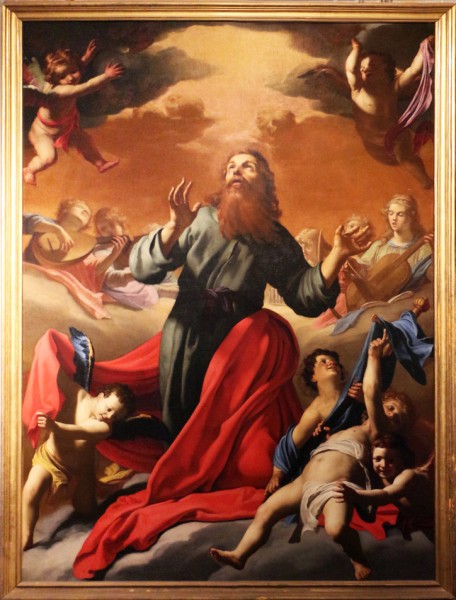
Gerrit van Honthorst, Saint Paul Caught up to the Third Heaven, 1620, the convent at the Church of Santa Maria della Vittoria
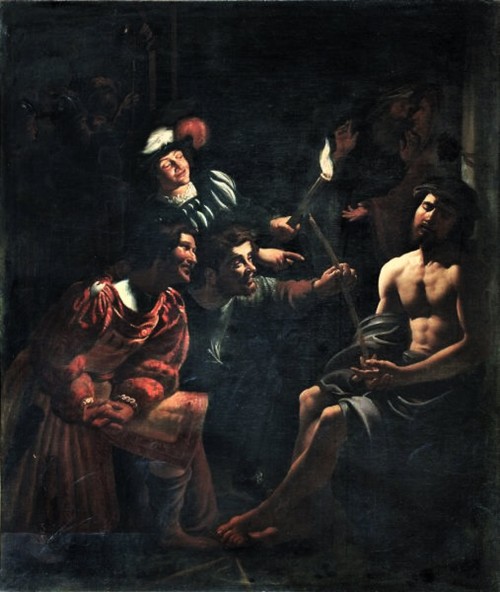
Gerrit van Honthorst, The Mocking of Christ, 1613, Church of Santa Maria della Concezione
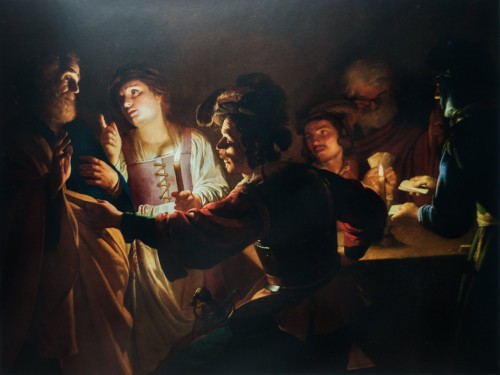
Gerrit van Honthorst, Merry Company, 1619, Galleria degli Uffizi, Florence

Gerrit van Honthorst, Christ Before the High Priest, fragment, National Gallery, London

Gerrit van Honthorst, Christ Crowned with Thorns (attributed), Church of Santa Maria in Aquiro
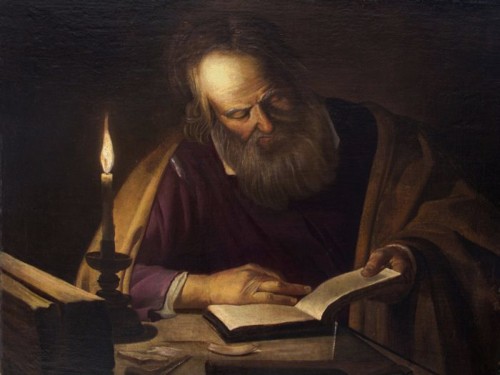
Gerrit van Honthorst, St Joseph Reading by Candlelight, the convent at the Church of San Francesco a Ripa

Gerrit van Honthorst, The Artist in his Atelier (attributed), approx., 1620, Galleria Nazionale d’Arte Antica, Palazzo Barberini
The turn of the XVI and XVII centuries in the Netherlands was a period of social unrest and religious struggles. In Utrecht, ruled by the Protestant, yet liberal elite, the artist was part of the Catholic minority. He learned his trade at the workshop of the famous Abraham Bloemaert. From among the forty-eight painters active in Utrecht at that time, twenty-five went to Italy. Van Honthorst did likewise. During several years he obtained valuable commissions for large-format works designated for churches and captured the minds and hearts of private collectors. His rapid career was a shock, even for him. Let us try and follow it.
The turn of the XVI and XVII centuries in the Netherlands was a period of social unrest and religious struggles. In Utrecht, ruled by the Protestant, yet liberal elite, the artist was part of the Catholic minority. He learned his trade at the workshop of the famous Abraham Bloemaert. From among the forty-eight painters active in Utrecht at that time, twenty-five went to Italy. Van Honthorst did likewise. During several years he obtained valuable commissions for large-format works designated for churches and captured the minds and hearts of private collectors. His rapid career was a shock, even for him. Let us try and follow it.
Without a doubt, Rome was the artistic center of Europe. It is enough to say, that in a city numbering approximately one hundred thousand inhabitants, there were about 2700 artists, including 572 foreigners. Half of these were artists from the Netherlands (Dutch and Flemish). They came to the city on the Tiber not only because of the outstanding works of art by Michelangelo and Raphael which were located there, the ancient heritage of the city, or a great number of collectors looking for exceptional paintings (free market of the arts), but also the opportunities to work at decorating the newly created palaces, churches, chapels, and buildings housing religious societies. Yet another magnet drawing them to the city was the works of Caravaggio hanging in the Roman churches, attracting young painters with their naturalism and tenebrism. The painter himself also interested them as a person, and as someone who introduced everyday people into religious paintings – dirty, old, and ugly.
We do not know when Honthorst came to Rome. His drawing (Nasjonalmuseet, Oslo) based on Caravaggio’s painting (The Crucifixion of St. Peter) is dated 1616, which proves that the Utrechtian was already in the city at that time. In his book Consideriazioni sulla pittura (1617-1621), Giulio Mancini describes him as a good “drawer” who attended the “accademia del vivo”, meaning the “school of life", which in turn means that he studied on the streets and squares of Rome. It is there, that he sketched live models and looked for inspiration for his paintings. From Utrecht he brought an outstanding drawing workshop, but also the drive to get to know the psyche of the portrayed, which is what the aforementioned Abraham Bloemaert emphasized. Van Honthorst was also, like no other, able to paint nocturnal scenes, illuminated by the artificial light of candles, torches, and lanterns. His notturni aroused interest, since they were not only exceptionally composed and atmospheric but also quite difficult to complete. The artist acquired the knowledge and skill necessary to complete them in Utrecht, however in Rome – in confrontation with Caravaggio and other caravaggionist painters – he perfected his workshop. Into his works, he introduced the light of candles and lamps, which were fully or partially obscured by figures, which provided surprising effects – the faces and robes of the portrayed people were lit up with the reflected light. The scenes were not filled with expression but intense intimacy. A magnificent example of this is the painting Merry Company with a Lute Player (1619, Galleria degli Uffizi, Florence). It was those very genre scenes (concerts, feasts, merry companies), painted for the free market, with figures sitting at a table, illuminated simply by the light of candles, technically exceptional, and surprising with their bold chiaroscuro and magnificently captured characters, brought Honthorst renown. This world and the company of the Roman low-born and taverns was well-known to the painter (similarly to Caravaggio), along with his friends making up a veritable Roman bohème of those times. From a police report, which is one of the few sources on the biography of Honthorst, we know that in the summer of 1619 he was arrested in the house of Vittoria da Rieti, with whom he had maintained sexual relations for the past ten months (according to the report). However, the reason for his arrest was not the bad reputation of the woman known as caritigiana da candela, but the artist's epee which was forbidden in some places including houses of ill repute. The fancy and humorous name cortigniana da candela (the candle courtesan) had its practical explanation – when visiting her time was measured according to a burning candle, which probably had to provide additional stimulation for artists to immortalize these attractive, merry women, on nocturnal paintings. But coming back to our protagonist, Honthorst spent one night in jail and then was released.
As Gherardo delle Notti, since that is what he was called in Rome, he was also valued by Vincenzo Giustiniani – an outstanding art collector of those times, in whose palace he lived, at the same time being able to admire magnificent paintings, including those painted by Caravaggio, who had died a few years prior. We also know, that Giustiniani bought three works painted by the Dutch artist, which today are scattered around the world, including the most famous one – Christ Before the High Priest (London, National Gallery), while in his book Discorso sopra la pittura (1618) he included him in a group of the most outstanding painters – next to Rubens and Ribera, however below Caravaggio, Annibale Carracci, and Guido Reni.

The previously-quoted Mancini claimed, that the painter dressed elegantly and had a melancholic nature. He was hospitable, but restrained, was not wont to drink or fight, and was open towards his colleagues and clients, whom he allowed to watch while he was painting, which was not something obvious. For example, Caravaggio never did this, jealously guarding his workshop. The patronage and approval of Giustiniani and the character traits of van Honthorst probably contributed to obtaining important commissions for the reredoses of Roman aristocrats both in Rome and outside the city.
The artist left the city on the Tiber in July 1620 and returned to Utrecht, where his career developed even more rapidly. He married and became a staid patrician and a renowned artist. He painted a lot, mainly for the free market, including the very popular scenes of concerts, feasts, and parties, often with a moralistic undertone. He painted for everyone – for Calvinists, scenes from the Old Testament, for Catholics from the New Testament. In time his style evolved, distancing itself from the experiences of the Roman period, and at the moment, when van Honthorst was employed by the English court, and later became the painter of several European courts – his painting became commercialized. It is then, that he pained an unlimited number of portraits.
Posthumously he left nearly three hundred unsold paintings.

Works of the artist in Rome
- The Beheading of St. John the Baptist, 1617, Church of Santa Maria della Scala
- The Concert, 1626, Galleria Borghese
- Saint Paul Caught up to the Third Heaven, 1620, Church of Santa Maria della Vittoria
- The Mocking of Christ, 1613, Church of Santa Maria della Concezione
- Christ Crowned with Thorns (attributed), Church of Santa Maria in Aquiro
- St Joseph Reading by Candlelight, the convent at the Church of San Francesco a Ripa
- The Artist in his Atelier (attributed), approx., 1620, Galleria Nazionale d’Arte Antica, Palazzo Barberini
- Susanna and the Elders, 1655, Galleria Borghese












